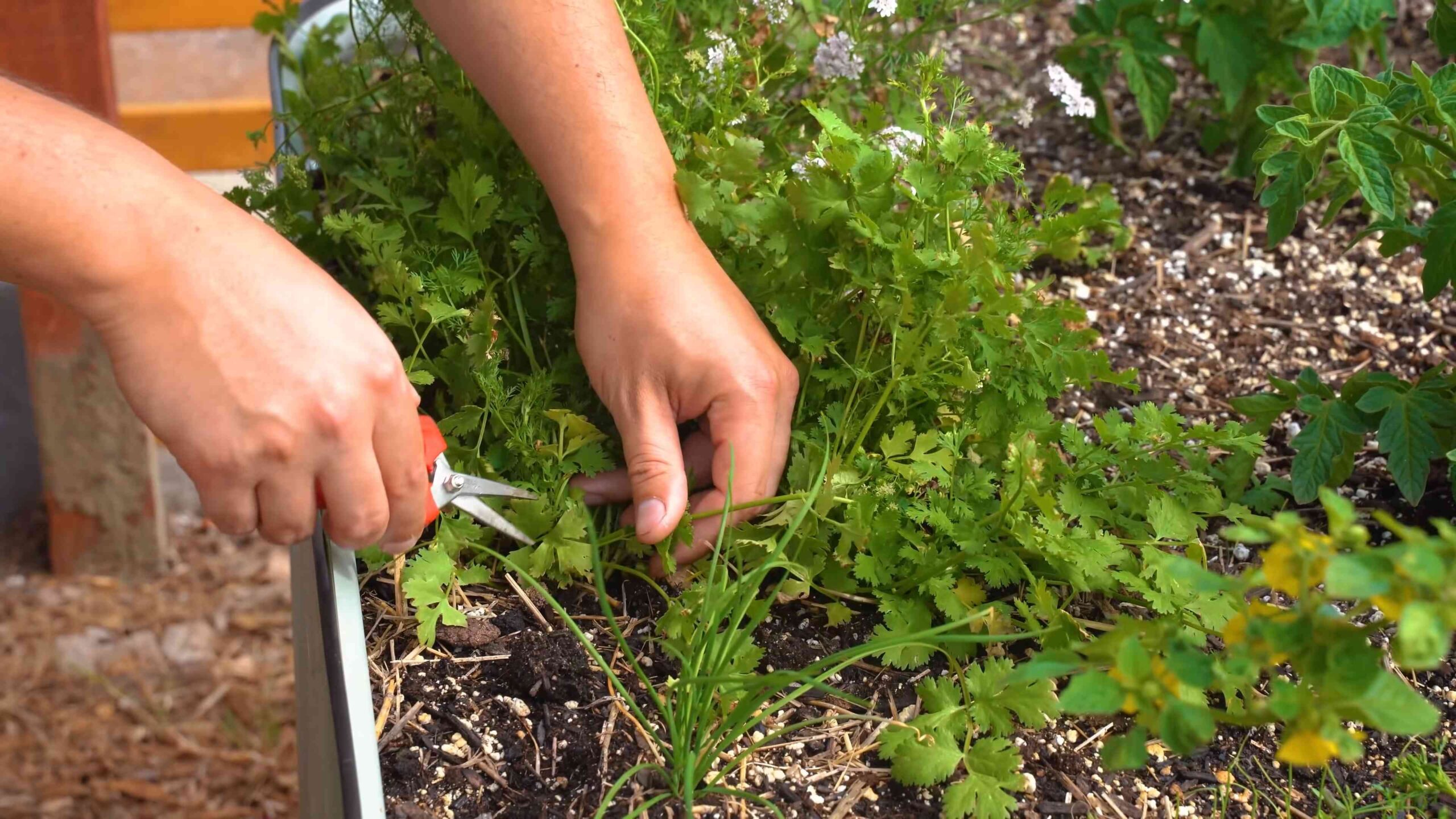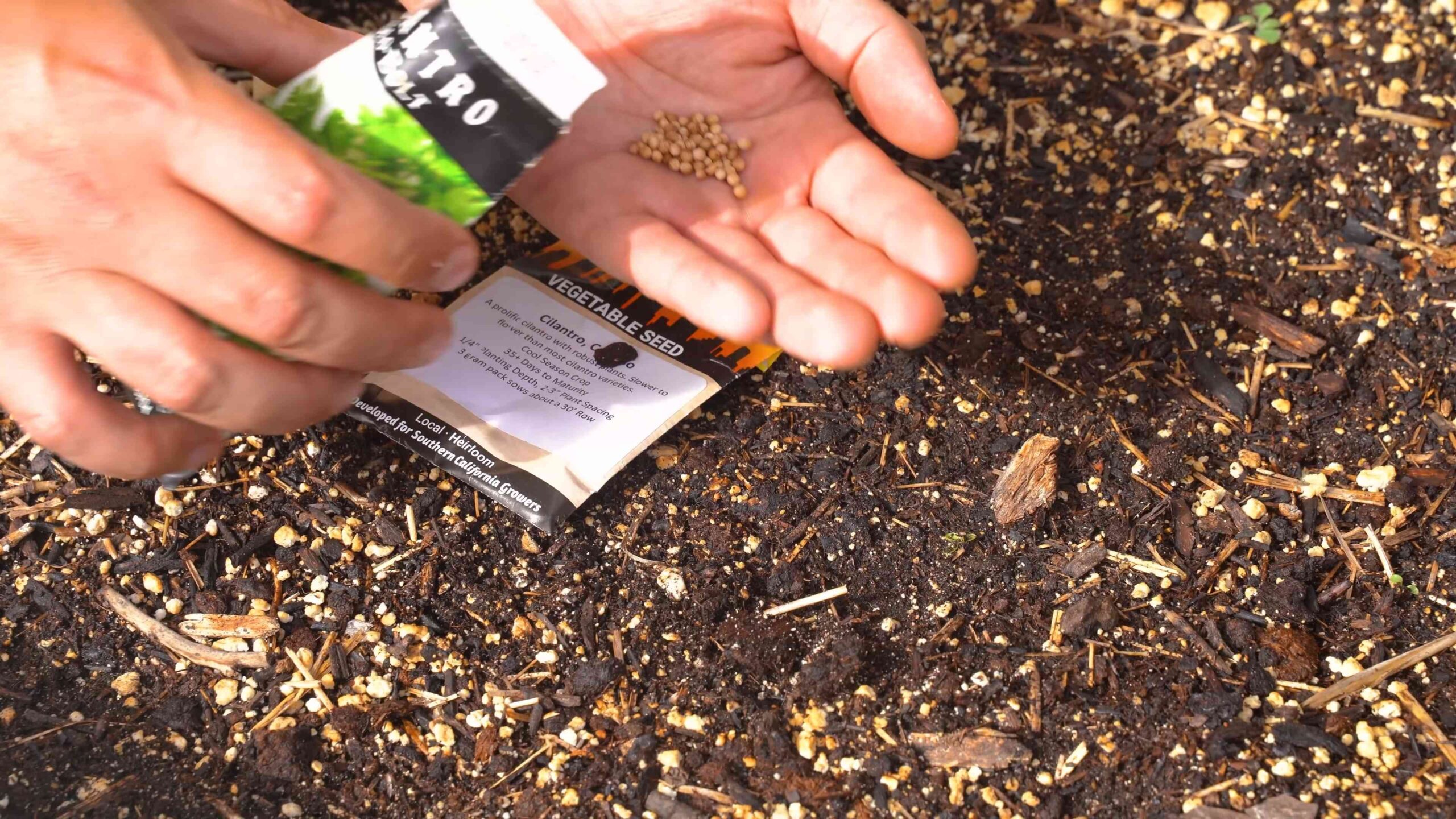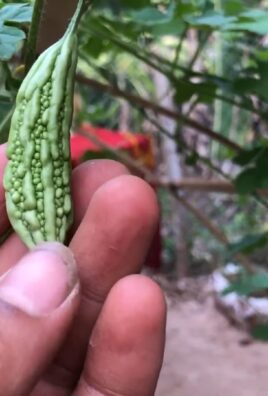Growing Cilantro for Beginners can seem daunting, but trust me, it’s easier than you think! Have you ever been halfway through making your favorite salsa or tacos, only to realize you’re completely out of fresh cilantro? It’s a culinary crisis, I know! For centuries, cilantro (also known as coriander in some parts of the world) has been a staple in cuisines from Latin America to Asia, adding a vibrant, citrusy kick that’s simply irreplaceable.
But what if I told you that you could have a constant supply of this flavorful herb right at your fingertips? That’s right, with a few simple tricks and a little bit of know-how, you can master growing cilantro for beginners in your own home garden, no matter how small your space is. This DIY guide will walk you through everything you need to know, from choosing the right seeds and soil to harvesting your bounty and preventing common problems like bolting.
Imagine the satisfaction of snipping fresh cilantro leaves whenever you need them, knowing exactly where they came from and how they were grown. Not only will you save money and reduce trips to the grocery store, but you’ll also enjoy the therapeutic benefits of gardening and the delicious flavor of homegrown herbs. So, let’s get started and unlock the secrets to successfully growing cilantro for beginners!

Growing Cilantro Like a Pro: A DIY Guide for Beginners
Hey there, fellow plant enthusiasts! I’m so excited to share my secrets to growing lush, vibrant cilantro right in your own home or garden. Cilantro, also known as coriander (the seeds are coriander, the leaves are cilantro – confusing, I know!), is a staple in so many cuisines, and having a fresh supply at your fingertips is a game-changer. Trust me, once you taste homegrown cilantro, you’ll never go back to the store-bought stuff.
This guide will walk you through everything you need to know, from choosing the right seeds to harvesting your bounty. Let’s get started!
Choosing Your Cilantro Seeds
Before we dive into the planting process, let’s talk about seeds. You have a couple of options here:
* Standard Cilantro Seeds: These are readily available at most garden centers and online retailers. They’re a good starting point for beginners.
* Slow-Bolt Varieties: Cilantro is notorious for bolting (going to seed) quickly, especially in hot weather. Slow-bolt varieties like ‘Slow Bolt’, ‘Long Standing’, or ‘Santo’ are bred to resist bolting, giving you a longer harvest window. I highly recommend these, especially if you live in a warmer climate.
* Organic Seeds: If you’re concerned about pesticides and herbicides, opt for organic cilantro seeds.
Preparing for Planting
Okay, you’ve got your seeds. Now, let’s get your planting area ready. Cilantro is relatively easy to grow, but a little preparation goes a long way.
* Sunlight: Cilantro thrives in partial shade, especially in hot climates. Too much direct sunlight can cause it to bolt prematurely. Aim for about 4-6 hours of sunlight per day. If you’re growing indoors, a sunny windowsill or grow light will do the trick.
* Soil: Cilantro prefers well-draining soil that’s rich in organic matter. A good potting mix or garden soil amended with compost is ideal.
* Container (if applicable): If you’re growing cilantro in a container, choose one that’s at least 6 inches deep and wide to allow for root growth. Make sure it has drainage holes to prevent waterlogging.
Planting Your Cilantro Seeds
Now for the fun part! Here’s how to plant your cilantro seeds:
1. Soak the Seeds (Optional but Recommended): Soaking your cilantro seeds in water for 24 hours before planting can help speed up germination. Just place the seeds in a small bowl of water and let them sit overnight.
2. Prepare the Soil: Fill your container or garden bed with your chosen soil mix. Moisten the soil thoroughly, but don’t make it soggy.
3. Sow the Seeds: Cilantro seeds are relatively large, so they’re easy to handle. Sow the seeds about 1/4 to 1/2 inch deep and about 1-2 inches apart. If you’re planting in rows, space the rows about 6-8 inches apart.
4. Cover the Seeds: Gently cover the seeds with soil and lightly pat it down.
5. Water Gently: Water the soil gently to avoid disturbing the seeds. A spray bottle or watering can with a gentle shower setting works well.
6. Label Your Planting: Don’t forget to label your planting with the date and type of cilantro you planted. This will help you keep track of your progress.
Caring for Your Cilantro Plants
Once your cilantro seeds have sprouted (usually within 7-10 days), it’s time to start caring for your plants. Here’s what you need to know:
* Watering: Cilantro needs consistent moisture, but it doesn’t like to be waterlogged. Water your plants when the top inch of soil feels dry to the touch. Avoid overhead watering, as this can lead to fungal diseases.
* Fertilizing: Cilantro doesn’t need a lot of fertilizer, but a light feeding every few weeks can help promote healthy growth. Use a balanced liquid fertilizer diluted to half strength.
* Thinning: If your cilantro seedlings are growing too close together, thin them out to give them more space to grow. This will also improve air circulation and reduce the risk of disease.
* Pest Control: Cilantro is generally pest-resistant, but it can occasionally be bothered by aphids or spider mites. If you notice any pests, try spraying your plants with insecticidal soap or neem oil.
* Bolting Prevention: As I mentioned earlier, cilantro is prone to bolting in hot weather. To prevent bolting, try these tips:
* Plant your cilantro in partial shade.
* Water your plants regularly to keep the soil cool and moist.
* Harvest your cilantro frequently to encourage new growth.
* Consider planting slow-bolt varieties.
Harvesting Your Cilantro
The best part about growing cilantro is, of course, harvesting it! You can start harvesting cilantro leaves about 45-55 days after planting.
1. Harvesting Leaves: To harvest cilantro leaves, simply snip them off with scissors or garden shears. Start with the outer leaves, leaving the inner leaves to continue growing.
2. Harvesting Seeds (Coriander): If you want to harvest coriander seeds, let your cilantro plants bolt. Once the flowers have dried and the seed pods have turned brown, you can harvest the seeds. Simply cut off the seed heads and hang them upside down in a paper bag to dry. Once the seeds are dry, you can store them in an airtight container.
3. Succession Planting: To ensure a continuous supply of cilantro, plant new seeds every few weeks. This is called succession planting.
Troubleshooting Common Cilantro Problems
Even with the best care, you might encounter some problems when growing cilantro. Here are some common issues and how to fix them:
* Yellowing Leaves: Yellowing leaves can be a sign of overwatering, underwatering, or nutrient deficiency. Check the soil moisture and adjust your watering accordingly. If the soil is dry, water your plants. If the soil is soggy, let it dry out before watering again. You can also try fertilizing your plants with a balanced fertilizer.
* Bolting: As I mentioned earlier, bolting is a common problem with cilantro. To prevent bolting, follow the tips I outlined above.
* Leggy Growth: Leggy growth (long, spindly stems) is usually a sign of insufficient light. Move your cilantro plants to a sunnier location or provide supplemental lighting.
* Pests: If you notice any pests on your cilantro plants, try spraying them with insecticidal soap or neem oil.
Growing Cilantro Indoors
Growing cilantro indoors is totally doable, and it’s a great way to have fresh herbs year-round. Here are some tips for growing cilantro indoors:
* Choose the Right Container: Select a pot that is at least 6 inches deep and wide to allow for adequate root growth. Make sure it has drainage holes.
* Use a Good Potting Mix: Use a high-quality potting mix that drains well.
* Provide Adequate Light: Cilantro needs at least 4-6 hours of sunlight per day. Place your cilantro plant in a sunny windowsill or under a grow light.
* Water Regularly: Keep the soil consistently moist, but not soggy.
* Fertilize Lightly: Fertilize your cilantro plant every few weeks with a balanced liquid fertilizer diluted to half strength.
* Pinch Back Regularly: Pinch back the tips of the stems to encourage bushier growth.
Extra Tips for Cilantro Success
Here are a few extra tips to help you grow the best cilantro ever:
* Don’t Overwater: Overwatering is one of the most common mistakes people make when growing cilantro. Make sure the soil is well-draining and only water when the top inch of soil feels dry.
* Harvest Regularly: Harvesting cilantro regularly encourages new growth and prevents bolting.
* Plant in the Right Season: Cilantro grows best in cool weather. In hot climates, plant cilantro in the spring or fall.
* Consider Companion Planting: Cilantro is a good companion plant for tomatoes, peppers, and other vegetables. It can help repel pests and attract beneficial insects.
Enjoy Your Homegrown Cilantro!
And there you have it! Everything you need to know to grow your own delicious cilantro. With a little care and attention, you’ll be enjoying fresh, flavorful cilantro in no time. Happy gardening! I hope you found this guide helpful, and I can’t wait to hear about your cilantro-growing adventures!

Conclusion
So, there you have it! Growing cilantro, even if you consider yourself a gardening novice, is entirely within your reach. This DIY approach, specifically tailored for beginners, unlocks a world of fresh, vibrant flavor right at your fingertips. Forget those wilted, overpriced bunches at the grocery store; imagine snipping fragrant cilantro leaves whenever you need them, adding a burst of freshness to your tacos, salads, soups, and more.
This isn’t just about saving money; it’s about experiencing the satisfaction of nurturing something from seed to harvest. It’s about connecting with nature, even in a small way, and enjoying the unparalleled taste of homegrown herbs. The difference between store-bought and homegrown cilantro is truly remarkable – the aroma is more intense, the flavor is brighter, and the leaves are noticeably more tender.
But the best part? It’s incredibly easy! We’ve broken down the process into simple, manageable steps, ensuring success even if you’ve never planted a seed before. From choosing the right container and soil to understanding the importance of sunlight and watering, we’ve covered everything you need to know to embark on your cilantro-growing journey.
Consider these variations to personalize your cilantro-growing experience:
* Succession Planting: Plant new seeds every few weeks to ensure a continuous supply of fresh cilantro throughout the growing season. This is especially important since cilantro tends to bolt (go to seed) quickly in hot weather.
* Container Gardening: If you’re short on space, cilantro thrives in containers. Choose a pot that’s at least 6 inches deep and wide to allow for root growth.
* Indoor Growing: With sufficient sunlight or a grow light, you can grow cilantro indoors year-round. This is a great option for those living in colder climates.
* Companion Planting: Plant cilantro alongside other herbs and vegetables that benefit from its presence. Cilantro is known to repel certain pests, making it a valuable addition to any garden.
* Seed Saving: Allow some of your cilantro plants to bolt and go to seed. You can then collect the seeds and use them to plant new crops, ensuring a continuous supply of cilantro for years to come.
Don’t be afraid to experiment and find what works best for you. Gardening is a learning process, and every mistake is an opportunity to grow (pun intended!). The key is to be patient, observant, and willing to adapt your approach as needed.
We are confident that you will be able to grow your own cilantro with these tips.
So, what are you waiting for? Grab some seeds, a pot, and some soil, and get started today! We encourage you to try this DIY trick and experience the joy of growing your own fresh cilantro. And most importantly, we want to hear about your experience! Share your photos, tips, and challenges in the comments below. Let’s create a community of cilantro enthusiasts and learn from each other. Happy gardening!
Frequently Asked Questions (FAQ)
Why is my cilantro bolting (going to seed) so quickly?
Bolting is a common issue with cilantro, especially in hot weather. Cilantro is a cool-season herb, and when temperatures rise, it tends to focus on reproduction rather than leaf production. To prevent bolting, try these tips:
* Plant in partial shade: Provide some afternoon shade to protect your cilantro from the hottest sun.
* Water regularly: Keep the soil consistently moist, especially during hot weather.
* Succession plant: Plant new seeds every few weeks to ensure a continuous supply of fresh cilantro.
* Harvest frequently: Regular harvesting encourages the plant to produce more leaves and delays bolting.
* Choose bolt-resistant varieties: Some cilantro varieties are specifically bred to be more resistant to bolting. Look for varieties like ‘Slow Bolt’ or ‘Santo’.
How often should I water my cilantro?
Cilantro prefers consistently moist soil, but not waterlogged. Water deeply whenever the top inch of soil feels dry to the touch. The frequency of watering will depend on factors such as the weather, the type of soil, and the size of the container. In hot, dry weather, you may need to water daily, while in cooler, wetter weather, you may only need to water every few days. Check the soil moisture regularly and adjust your watering schedule accordingly.
What kind of soil is best for growing cilantro?
Cilantro thrives in well-draining soil that is rich in organic matter. A good potting mix specifically formulated for herbs or vegetables is ideal. You can also amend your garden soil with compost or other organic materials to improve its drainage and fertility. Avoid heavy clay soils, as they can become waterlogged and lead to root rot. The ideal soil pH for cilantro is between 6.0 and 7.0.
How much sunlight does cilantro need?
Cilantro needs at least 6 hours of sunlight per day to thrive. However, in hot climates, it benefits from some afternoon shade to prevent bolting. If you’re growing cilantro indoors, place it near a sunny window or use a grow light to provide adequate light. Rotate the plant regularly to ensure that all sides receive equal exposure to light.
Can I grow cilantro indoors?
Yes, you can absolutely grow cilantro indoors! Choose a pot that’s at least 6 inches deep and wide, and use a well-draining potting mix. Place the pot near a sunny window that receives at least 6 hours of sunlight per day, or use a grow light to supplement natural light. Water regularly, keeping the soil consistently moist but not waterlogged. Fertilize every few weeks with a balanced liquid fertilizer.
How do I harvest cilantro?
Harvest cilantro by snipping off the outer leaves with scissors or pruning shears. Avoid cutting the entire plant at once, as this can stunt its growth. Regular harvesting encourages the plant to produce more leaves. You can harvest cilantro leaves at any time, but they are most flavorful before the plant begins to bolt.
What can I do with cilantro seeds (coriander)?
When your cilantro plant bolts, it will produce seeds, which are known as coriander. You can harvest these seeds and use them as a spice in cooking. Coriander seeds have a warm, citrusy flavor that complements a variety of dishes. You can also save the seeds and use them to plant new cilantro crops.
My cilantro leaves are turning yellow. What’s wrong?
Yellowing cilantro leaves can be caused by several factors, including:
* Overwatering: Waterlogged soil can lead to root rot, which can cause the leaves to turn yellow.
* Underwatering: Insufficient watering can also cause the leaves to turn yellow.
* Nutrient deficiency: A lack of essential nutrients, such as nitrogen, can cause the leaves to turn yellow.
* Pests or diseases: Certain pests and diseases can also cause the leaves to turn yellow.
To diagnose the problem, check the soil moisture, look for signs of pests or diseases, and consider fertilizing with a balanced fertilizer.
Is cilantro easy to grow from seed?
Yes, cilantro is relatively easy to grow from seed. However, cilantro seeds have a hard outer shell, which can make germination slow and uneven. To improve germination, you can soak the seeds in water for 24 hours before planting. You can also gently crush the seeds before planting to help them absorb water more easily.
What are some common pests and diseases that affect cilantro?
Cilantro is generally resistant to pests and diseases, but it can be affected by aphids, spider mites, and fungal diseases such as powdery mildew. To prevent pest and disease problems, provide good air circulation, avoid overwatering, and inspect your plants regularly for signs of infestation or disease. If you notice any problems, treat them promptly with an appropriate insecticide or fungicide.





Leave a Comment